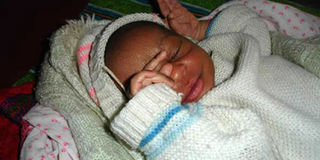Invest in saving newborn babies

While progress has been made, the figures show that countries, particularly in sub-Saharan Africa, have a lot to do to bring their newborn mortality rate down to the high-income average.
What you need to know:
- The issue: Newborn mortality
- Our view: With political will, commitment and consistent investment in the health sector, especially in maternal health, these proposals are achievable.
A report by the United Nations Children’s Fund (UNICEF) on newborn mortality – Every child alive, the urgent need to end newborn deaths – released last month indicates that global deaths of newborn babies remain alarmingly high, especially among the world’s poorest countries.
While the survey shows the world has more than halved the number of deaths among children under the age of five in the last quarter century, UNICEF says similar progress in ending deaths among children less than one month old has not been made, yet the majority of these deaths are preventable.
In low-income countries, the report shows that the average newborn mortality rate is 27 deaths per 1,000 births; but in high-income countries, that rate is 3 deaths per 1,000. Newborns from the riskiest places to give birth are up to 50 times more likely to die than those from the safest places. The report further highlights that 8 of the 10 most dangerous places to be born are in sub-Saharan Africa where pregnant women are less likely to receive assistance during delivery due to poverty, conflict and weak institutions.
In East Africa, Rwanda was featured as the safest country for mothers and their newborns. For every 1,000 babies born in 2016, the report states that 16 died before the end of their first month – a significant progress from 41 deaths per 1,000 births in 1990. Uganda came second after recording 21 deaths, Tanzania with 22, Kenya registered 23, Burundi 24 and South Sudan recorded 38 children dying per 1,000 births before their first month.
While progress has been made, the figures show that countries, particularly in sub-Saharan Africa, have a lot to do to bring their newborn mortality rate down to the high-income average. For instance, Unicef notes that Rwanda’s success in reducing child mortality rate lies in its political will to invest in health systems that prioritise newborns and reaching out to the poorest and most marginalised. Such examples should serve as benchmarks for countries that still lag behind.
The report makes practical proposals countries can adopt to reduce child mortality rate. They include: Recruiting, training, retaining and managing sufficient numbers of doctors, nurses and midwives with expertise in maternal and newborn care; guaranteeing clean, functional health facilities within the reach of every mother and baby; providing every mother and baby with the life-saving drugs and equipment needed for a healthy start in life; and empowering adolescent girls, mothers and families to demand and receive quality care.
With political will, commitment and consistent investment in the health sector, especially in maternal health, these proposals are achievable.
Our commitment to you
We pledge:
• To be accurate and fair in all we do.
• To be respectful to all in our pursuit of the truth.
• To refuse to accept any compensation beyond that provided by Monitor Publications Ltd. for what we do in our news gathering and decision-making.
Further, we ask that we be informed whenever you feel that we have fallen short in our attempt to keep these commitments.




